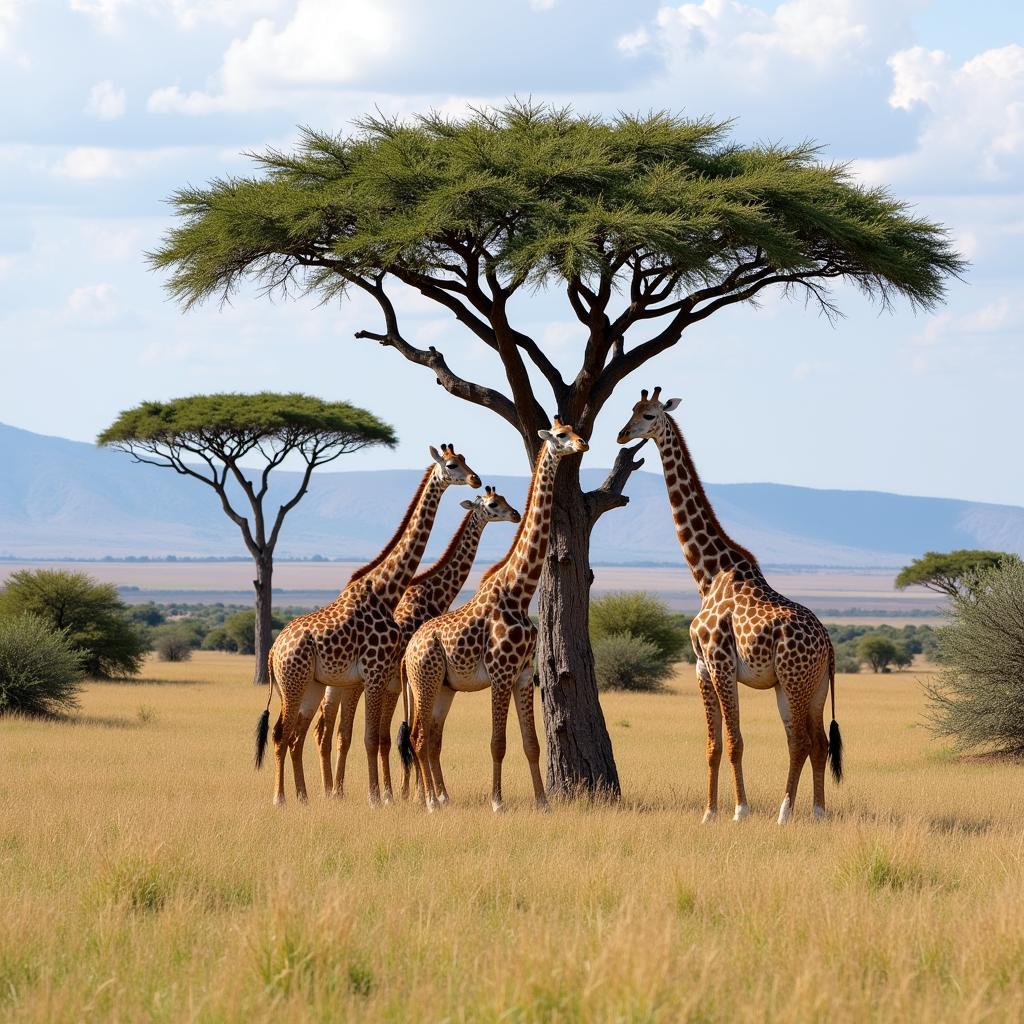African Giraffe Scientific Name: Unveiling the Gentle Giant
The African giraffe, scientifically known as Giraffa camelopardalis, is a majestic creature that captivates the imagination. Its towering height, distinctive patterns, and graceful movements have earned it a special place in the animal kingdom.
A Closer Look at Giraffa Camelopardalis
The scientific name Giraffa camelopardalis perfectly encapsulates the giraffe’s unique appearance. “Giraffa” is believed to originate from the Arabic word “zarafah,” meaning “tall one.” “Camelopardalis” stems from the ancient Greek belief that the giraffe was a hybrid of a camel and a leopard, reflecting its camel-like shape and leopard-like spots.
Nine Subspecies, Nine Unique Patterns
While we often speak of the African giraffe as a single species, there are actually nine recognized subspecies, each with its own distinct geographical range and coat pattern. These subspecies are:
- Masai Giraffe (G. c. tippelskirchi): Found in Kenya and Tanzania, they boast jagged, star-like spots.
- Reticulated Giraffe (G. c. reticulata): Native to Kenya, Ethiopia, and Somalia, they showcase a bold pattern of polygonal, liver-colored spots separated by a network of bright white lines.
- Angolan Giraffe (G. c. angolensis): Inhabiting Namibia, Botswana, and Zimbabwe, their spots are large and brown, often extending down their legs.
- Kordofan Giraffe (G. c. antiquorum): Found in Central African Republic, southern Chad, and possibly Cameroon, they exhibit irregular spots that are generally smaller and more numerous than other subspecies.
- Nubian Giraffe (G. c. camelopardalis): Ranging in Ethiopia, South Sudan, and Uganda, their spots are large, chestnut-colored, and typically confined to the torso, leaving the legs mostly white.
- Rothschild’s Giraffe (G. c. rothschildi): Found in Kenya and Uganda, their spots are dark brown, large, and irregular, often with jagged edges and extending to the hooves.
- South African Giraffe (G. c. giraffa): Inhabiting South Africa, Botswana, Zimbabwe, and Mozambique, they are characterized by rounded or blotched spots that extend to their lower legs.
- Thornicroft’s Giraffe (G. c. thornicrofti): Endemic to Zambia, their spots are star-shaped or leaf-like and vary in color from light brown to almost black.
- West African Giraffe (G. c. peralta): Once widespread across West Africa, they are now critically endangered and found only in a small region of Niger. Their spots are light-colored and widely spaced.
The Tallest Mammal on Earth
Standing at an average height of 14 to 19 feet, giraffes are the tallest mammals on Earth. Their long necks, which can measure up to 6 feet in length, are a testament to evolution, allowing them to reach high into the trees for food, giving them a competitive advantage over other herbivores.
More Than Just a Long Neck: Other Adaptations
While their long necks are their most striking feature, giraffes possess other adaptations that contribute to their survival in the African savanna. Their long legs allow for efficient movement across vast distances, while their keen eyesight helps them to spot predators from afar. They also have a specialized circulatory system that regulates blood flow to their heads, preventing them from fainting when they bend down to drink.
Giraffes: A Keystone Species
Giraffes play a crucial role in their ecosystem. As browsers, they help to shape the vegetation structure, which benefits other herbivore species. Their presence also attracts tourism, contributing to conservation efforts and local economies.
 Group of African giraffes grazing in the African savanna
Group of African giraffes grazing in the African savanna
Conclusion
The African giraffe, Giraffa camelopardalis, is a testament to the wonders of evolution. Its unique adaptations, striking appearance, and vital role in the ecosystem make it a true icon of the African savanna. By understanding and appreciating these gentle giants, we can contribute to their conservation and ensure that future generations can continue to marvel at their grandeur.
FAQs
1. What is the scientific name for a giraffe?
The scientific name for an African giraffe is Giraffa camelopardalis.
2. How many subspecies of giraffe are there?
There are nine recognized subspecies of African giraffe.
3. What is the tallest giraffe ever recorded?
The tallest giraffe ever recorded was a male named George, who stood at a staggering 19 feet 3 inches tall.
4. Do all giraffes have the same spot pattern?
No, each subspecies of giraffe has its own distinct coat pattern.
5. What do giraffes eat?
Giraffes are herbivores and primarily feed on leaves, buds, and fruits of trees, particularly acacia trees.
6. How long do giraffes live?
In the wild, giraffes typically live for 20 to 25 years.
7. Are giraffes endangered?
While not all giraffe subspecies are endangered, their populations are declining due to habitat loss, poaching, and human-wildlife conflict.
Related Resources:
Need assistance? Contact us at:
Phone Number: +255768904061
Email: kaka.mag@gmail.com
Address: Mbarali DC Mawindi, Kangaga, Tanzania
Our customer support team is available 24/7.


